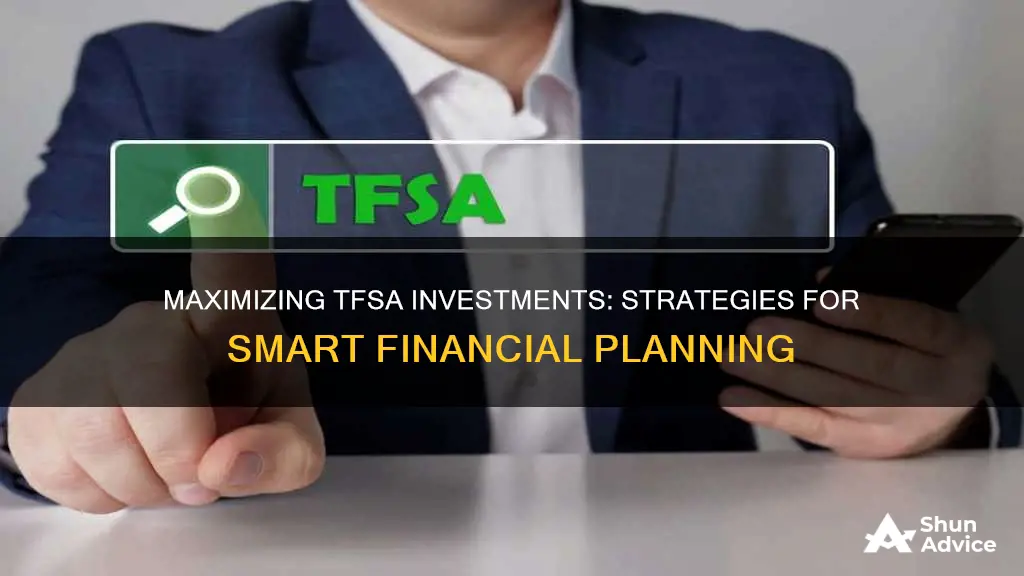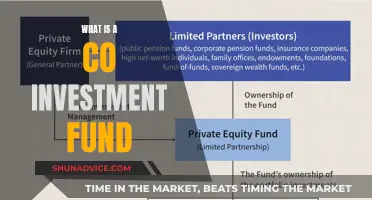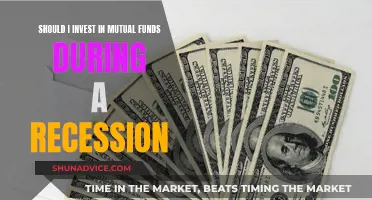
Tax-Free Savings Accounts (TFSAs) are a great way to save and invest funds while shielding your investment returns from taxes. TFSAs are versatile and can be used for various purposes, including retirement savings, a down payment for a house, debt repayment, or an emergency fund. The best way to use your TFSA is to put together a diversified, low-cost portfolio with an asset mix that suits your goals and risk tolerance.
There are two main ways to invest in a TFSA: the self-directed DIY method, where you decide what to invest in yourself, and the managed method, where a financial institution manages your investments for you.
There are several options for investing or saving within your TFSA account, including keeping your cash in a savings account, guaranteed income certificates (GICs), exchange-traded funds (ETFs), individual stocks and bonds, and mutual funds.
It's important to note that the level of risk you're willing to take on and your savings goals will influence how you choose to invest your TFSA funds.
| Characteristics | Values |
|---|---|
| Account Type | Tax-Free Savings Account (TFSA) |
| Account Purpose | Saving/investing funds while shielding investment returns (dividends, interest, and capital gains) from taxes for life |
| Annual Contribution Limit | $6,500 for 2023 and $7,000 for 2024 |
| Investment Options | Guaranteed Income Certificates (GICs), ETFs, Index Funds, Individual Stocks and Bonds, Mutual Funds, Government and Corporate Bonds, Exchange-Traded Funds (ETFs), Certain Shares of Small Business Corporations |
| Benefits | Save money and invest tax-free over your lifetime, easy to open, flexible withdrawal options, no impact on benefits, can be used for multiple goals |
| Drawbacks | Withdrawals might prevent long-term thinking, holdings can be seized, over-contributions are taxed, non-qualified investments are taxed, prohibited investments are heavily taxed |
What You'll Learn

Guaranteed Income Certificates (GICs)
Guaranteed Investment Certificates (GICs) are a secure, low-risk investment option that guarantees 100% of your original principal while earning annual interest at a fixed or variable rate based on a specific formula. GICs are often purchased as retirement savings vehicles because they provide a low-risk fixed rate of return. They are insured by the Canadian government for up to $100,000 Canadian per account.
GICs are similar to certificates of deposit sold by banks in the US. When buying a GIC, investors deposit money for a fixed length of time, receiving interest on that money and the principal when the investment matures. The money is lent to the bank, which then pays interest in return. GICs are considered safe investments because the financial institutions that sell them are legally obligated to return investors' principal and interest.
GICs offer a slightly higher return than Treasury bills (or T-bills), making them an excellent option to diversify a stream of liquid, safe securities in a portfolio. GICs are also eligible for CDIC Insurance, which means that even if the bank fails, investors are insured for up to $100,000 Canadian by the Canadian Deposit Insurance Corporation (CDIC).
There are different types of GICs to choose from, including guaranteed-return GICs, interest rate-linked GICs, and equity-linked GICs. The right choice of GIC depends on your financial situation, investment goals, and time horizon. For example, if you are saving for a new car, a cashable or personal redeemable GIC is a better choice as they offer the flexibility to redeem your cash anytime.
GICs can be held within a TFSA, and when they are, the interest will be tax-sheltered.
T-Bills vs Short-Term Bond Funds: A Safer Investment Bet?
You may want to see also

Government and corporate bonds
Bonds are debt securities issued by governments and corporations to raise money. When you invest in a bond, you are essentially loaning money to the government or corporation that issued it. In return, you receive interest payments at predetermined intervals, and the principal is returned to you when the bond matures and the loan comes due.
There are two main types of bonds: government and corporate bonds. Government bonds are issued by federal, provincial, or municipal governments. They are considered to be of high quality and low risk, with federal government bonds being the most secure. Corporate bonds, on the other hand, are issued by corporations and tend to offer a higher rate of return but are also riskier.
When investing in bonds, it is important to consider the term, maturity date, and coupon rate. The term is the length of time from the date the bond is issued to its maturity date, typically ranging from 1 to 20 years. The maturity date is when the bond term ends, and your investment capital is returned. The coupon rate is the interest rate paid to the bondholder per year, with payments typically made monthly.
You can buy Canadian bonds in two ways: purchasing a bond fund through your brokerage account or buying bonds directly from the issuing government or corporation through a financial broker. The best way to buy bonds is usually to purchase a bond fund, such as a bond ETF, which provides a diverse portfolio of bonds at a low cost.
Bonds are a great way to generate passive income and reduce the volatility of your investment portfolio. However, it is important to remember that they are not risk-free. The value of bonds is sensitive to interest rate changes, and there is always a risk of default by the bond issuer.
Artificial Intelligence: Mutual Funds for Future Tech Investors
You may want to see also

Exchange-traded funds (ETFs)
ETFs are ideal for those who want the ease of stock trading but the diversification benefits of mutual funds. They are a collection of investments, such as stocks or bonds, that allow you to invest in multiple securities simultaneously. ETFs are traded on stock exchanges and can be bought and sold from other owners throughout the day, whereas mutual funds are bought and sold from the issuer based on their end-of-day price. ETFs are also more transparent than mutual funds, as their holdings are typically published online daily.
ETFs often have lower fees than other types of funds, making them a cost-effective way to gain exposure to a broad basket of securities. The management costs and commission fees of ETFs are generally lower than those of other types of funds. They are also more tax-efficient than mutual funds, as buying and selling occurs through an exchange, and the ETF sponsor does not need to redeem shares each time an investor wishes to sell or issue new shares each time an investor wishes to buy.
ETFs can be actively or passively managed. Passively managed ETFs aim to replicate the performance of a broader index, such as the S&P 500, while actively managed ETFs involve portfolio managers making decisions about which securities to include in the portfolio. Actively managed ETFs can be more expensive for investors but offer benefits over passive ETFs.
ETFs can be further categorised by the types of investments held within the fund. Some common types of ETFs include:
- Stock ETFs: A basket of stocks that track a single industry or sector, providing diversified exposure to that industry.
- Bond ETFs: These ETFs invest in bonds and are used to provide regular income to investors.
- Commodity ETFs: Invest in commodities such as gold or crude oil, providing a way to diversify a portfolio.
- Currency ETFs: Track the performance of currency pairs, allowing investors to speculate on currency prices based on economic and political developments.
- Bitcoin or Crypto ETFs: Expose investors to the price movements of cryptocurrencies like Bitcoin or Ethereum.
When investing in ETFs, individuals can use online brokers, traditional broker-dealers, or robo-advisors. Many platforms offer commission-free trading, meaning investors don't have to pay fees to the platform providers. ETFs are also available through retirement accounts.
ETFs are a versatile investment option that can provide instant diversification and lower fees compared to other types of funds. They are a popular choice for those seeking a cost-effective way to gain exposure to a broad range of securities.
A Simple Guide to Investing in the S&P 500 Index Funds
You may want to see also

Stocks
To be considered a qualified investment, the stocks you invest in must be listed on a designated stock exchange, such as the Toronto Stock Exchange, the TSX Venture Exchange, the New York Stock Exchange, or Nasdaq. The Canadian Department of Finance maintains a list of more than 40 stock exchanges worldwide. It is a good idea to check that the stocks you want to invest in are listed on one of these exchanges before purchasing them.
If you are invested in dividend-paying foreign stocks, note that you might have to pay a withholding tax on the dividend you receive. This is because many countries impose a tax on the dividends they pay to foreign investors. This tax rate varies from country to country, but for American dividend-paying stocks, the rate is 15%.
There are two ways to invest in stocks within your TFSA:
- Through a financial advisor at a bank or credit union. You can instruct your advisor to buy specific stocks or take their advice on which stocks to choose.
- Do-it-yourself. Open an account at an online brokerage or through the self-directed portal at your bank, and buy stocks yourself for reduced fees.
It is important to remember that if you plan to buy securities yourself within a TFSA, do not day trade. While day trading isn't allowed, it's easy to do by mistake, especially if you are unaware of this rule. If you break the rules, you'll be fined.
Seed Funding: Strategies for Early-Stage Investment Success
You may want to see also

Mutual funds
When you invest in a mutual fund, your money is pooled with that of other investors. The fund manager then allocates the funds to produce capital gains returns or income through dividends. Mutual funds are strictly regulated and transparent, so you can easily check how your fund is performing by looking at its market cap changes.
There are some drawbacks to investing in mutual funds with your TFSA. You will have a lack of decision-making power, as you cannot vote on major changes. The fund's performance is also dependent on the fund manager and the underlying securities. Additionally, there are expense ratios and, in some cases, commissions to consider, which will cut into your returns.
However, overall, mutual funds are a good option if you are not actively managing your investments. They offer a good balance between risk and returns and are a practical long-term saving strategy when used with a TFSA, as you will not have to pay taxes on your gains.
Hedge Fund GPs: Benefits of Investing in Their Own Fund
You may want to see also
Frequently asked questions
TFSA stands for Tax-Free Savings Account. It is a registered account that Canadians can use to save or invest funds while shielding investment returns (dividends, interest, and capital gains) from taxes for life.
Common types of qualified investments include Guaranteed Income Certificates (GICs), government and corporate bonds, exchange-traded funds (ETFs), certain shares of small business corporations, and mutual funds.
How you choose to invest the money in your TFSA depends on the level of risk you’re willing to take on, as well as the time horizon of your savings goals. It's important to assess your financial goals, investment time horizon, risk tolerance, investment knowledge, fees, and portfolio size before deciding how to invest your TFSA.
The government announces the contribution limit each year, and unused contribution room can be carried forward indefinitely. The contribution limit for 2023 was $6,500, and for 2024 it is $7,000.
Yes, you can open more than one TFSA. However, remember that the contribution limit applies across all your TFSAs, so you must stay within your available contribution room.







